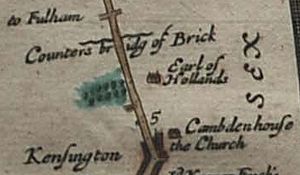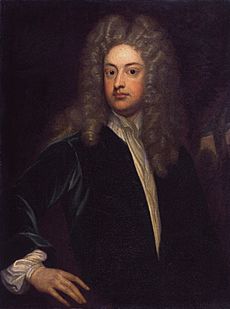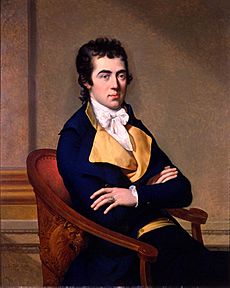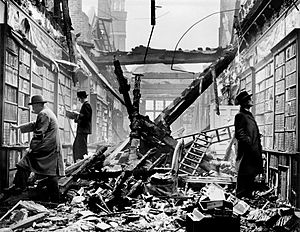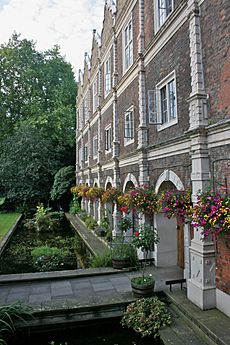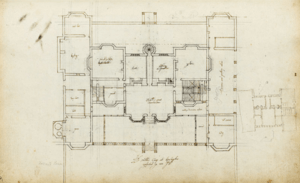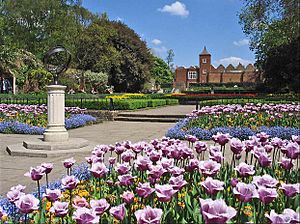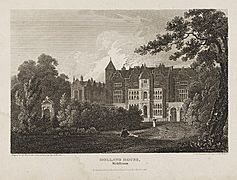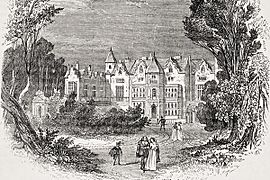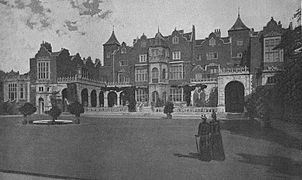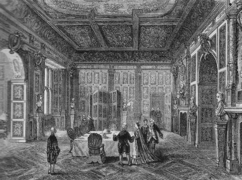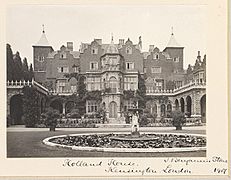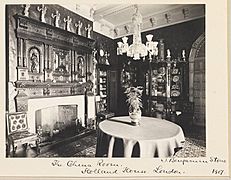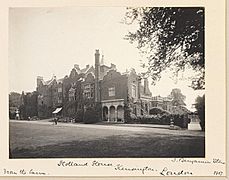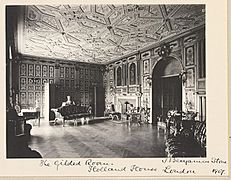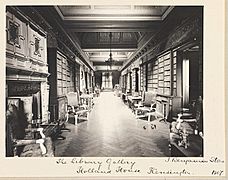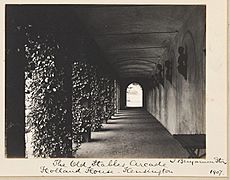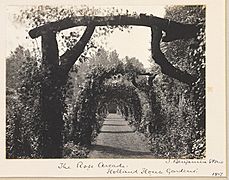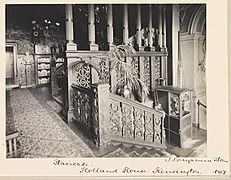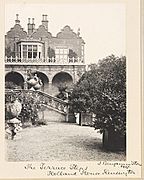Holland House facts for kids
Quick facts for kids Holland House |
|
|---|---|

Holland House in 1896 and its remains in 2014
|
|
| Location | London |
| Built | 1605 |
| Built for | Sir Walter Cope |
| Architectural style(s) | Jacobean |
| Owner | Royal Borough of Kensington and Chelsea |
|
Listed Building – Grade I
|
|
| Designated | 29 Jul 1949 |
| Reference no. | 1267135 |
| Lua error in Module:Location_map at line 420: attempt to index field 'wikibase' (a nil value). | |
Holland House, first known as Cope Castle, was a beautiful old country house in Kensington, London. It was built in 1605 by a diplomat named Sir Walter Cope. The house was located on a large estate, which is now Holland Park.
Over time, the house changed owners. It became the property of the Rich family, then the Fox family. In the 1800s, it was a famous meeting place for important politicians and writers. Sadly, Holland House was mostly destroyed during the Blitz in 1940. This was a time when German planes dropped many bombs on London during World War II.
Today, only a part of the house, the east wing, and some ruins remain. Other buildings and gardens are still there. In 1949, the ruins were made a grade I listed building. This means it is a very important historic site. The Royal Borough of Kensington and Chelsea now owns Holland House.
Contents
Holland House: A Look Back at Its History
Building the House: The 17th Century Beginnings
Sir Walter Cope started building Holland House in 1604. He hired an architect named John Thorpe. The house was built on a huge estate, about 500 acres. This area stretched across what is now Holland Park Avenue to Fulham Road. The estate even had special trees brought in from other countries.
Sir Walter Cope often hosted the King and Queen at his new home. In 1608, a letter writer named John Chamberlain mentioned that he saw everything but couldn't touch anything. Even the cherries were saved for the Queen!
In 1612, King James I stayed at Cope Castle after his oldest son passed away. His other children, Prince Charles and Princess Elizabeth, joined him later.
New Owners and a New Name
Sir Walter Cope died in 1614 without a son. His daughter, Isabel Cope, inherited the house. In 1616, she married Henry Rich, 1st Earl of Holland. The house then became his property. King James I gave Henry Rich the titles of Baron Kensington and Earl of Holland. After becoming Earl of Holland, he renamed the building Holland House.
During the English Civil War, Henry Rich supported the King. He was later executed in 1649. After his death, the house was used as an army headquarters. Oliver Cromwell, a famous leader, visited it often.
Henry Rich's oldest son, Robert Rich, inherited the house. He later became the Earl of Warwick. This is why you can find Warwick Road and Warwick Gardens nearby today.
A King's Choice: William III and Holland House
King William III (who ruled from 1689 to 1702) thought about moving to Holland House. He had asthma, and the damp air at his palace, Palace of Whitehall, made it worse. In 1689, he wanted to find a new home. He needed a place close enough to London for royal business but far enough away for better air.
He considered Holland House and stayed there for a few weeks. Some of his letters are even dated from Holland House. In the end, he bought a nearby house, which became Kensington Palace.
Holland House Through the Centuries
The 18th Century: Writers and New Families
In 1716, the famous writer Joseph Addison married Charlotte Myddelton. She was the widow of Edward Rich, who had owned Holland House. Addison lived at Holland House after his marriage. He died there three years later in 1719. Today, several streets near Holland Park are named after him, like Addison Avenue.
The Edwardes and Fox Families
The house was passed down through the Rich family. Eventually, it went to Lady Elizabeth Rich. She was married to Francis Edwardes. Their family owned a lot of land in Wales. Holland House then became part of the Edwardes family's property.
However, the Edwardes family didn't seem to live in Holland House. In 1746, they rented it out to Henry Fox, 1st Baron Holland. He was an important politician. He rented the house and 64 acres of land for 99 years.
By 1768, Henry Fox bought the entire estate, about 200 acres. He built another country house for his retirement. Henry Fox died at Holland House in 1774. The house then passed to his grandson, Henry Vassall-Fox, who became the third Baron Holland. In 1797, he married Elizabeth Vassell.
The 19th Century: A Social Hub and Estate Changes
Henry Vassall-Fox, the third Baron Holland, started building new homes on the estate. He used these projects to get money for his family's lifestyle. He wrote in 1823 that marking out new roads was "important profitable but melancholy."
His wife, Lady Holland, was not so sure about the benefits. She thought it would take many generations for the family to truly profit. In 1849, he even mortgaged Holland House to pay for new roads and sewers.
He died in 1859 without children. The title of Baron Holland ended. His wife, Lady Mary Augusta Coventry, inherited the estate. She sold much of the land over the next few years. In 1874, she sold Holland House to a distant relative, Henry Fox-Strangways, 5th Earl of Ilchester. He wanted to protect the house and its grounds from being sold off to developers. Lady Holland was allowed to keep living in the house.
Holland House: A Famous Meeting Place
Holland House became a very important social, literary, and political center. It was the main meeting place for the Whig party, a political group in Britain. The third Baron Holland hosted many dinners for them.
Many famous people visited Holland House. These included the historian Thomas Babington Macaulay, poets like Lord Byron and Thomas Campbell, and politicians like Lord Melbourne and Benjamin Disraeli. Writers such as Charles Dickens and Sir Walter Scott also came.
One visitor, Charles Greville, described the house as "strange" but also a place of "luxury and enjoyment." He said that if Holland House ever closed, it would leave a big empty space in society. He called it "the house of all Europe."
The fame of Holland House even reached other countries. In 1831, Henry John Boulton, who was born in Holland House, built a home in Toronto, Canada. He named it Holland House to remember his birthplace.
The 20th Century: Development and Destruction
When Henry Fox-Strangways, 5th Earl of Ilchester inherited Holland House in 1874, he wanted to save it. He started to develop some of the land to the west of the house. This area became Melbury Road, named after his family's home in Dorset. Lady Holland, who still lived in the house, was not happy about the building work.
After Lady Holland died in 1889, the Earl moved into Holland House. More land was developed over time.
The Ilchester Estate
Giles Fox-Strangways, 6th Earl of Ilchester inherited the house in 1905. During his time, much of the land to the west was developed for housing. This area became known as the Ilchester Estate. It included streets like Ilchester Place and Abbotsbury Road. Some roads were still named after Joseph Addison.
Destroyed in the Blitz
In 1939, King George VI and Queen Elizabeth attended the last big ball held at Holland House. The next year, in September 1940, the German bombing raids on London began. These raids were called the Blitz.
On the night of September 27, Holland House was hit by 22 firebombs during a ten-hour attack. Most of the house was destroyed. Amazingly, the east wing and almost all of the library remained undamaged. Some old books from the 1500s, like the Boxer Codex, survived.
After the War: Preservation and New Uses
After the war, in 1949, Holland House was given Grade I listed building status. This was done to protect important historic buildings damaged during the war. The house remained a burned-out ruin until 1952. Then, the 6th Earl sold the house and 52 acres of land to the London County Council.
Today, the remains of Holland House are a beautiful background for the open-air Holland Park Theatre. This is where Opera Holland Park performs. The Orangery is now used for exhibitions and events. The old Summer Ballroom is now a restaurant called The Belvedere. The former ice house is now an art gallery. The grounds also have sports facilities, including a cricket pitch, football pitch, and tennis courts.
Holland House: Design and Gardens
Holland House had a common design for large houses of its time. It had a main central part and two porches. Between 1625 and 1635, the first Earl of Holland made the house much bigger. He added two new wings and arcades (covered walkways).
The house had a special main room called the "Gilt Chamber." This room was decorated with gold and bright colors. It had fancy carvings and paintings. The room also displayed many busts (sculptures of heads) of famous people. These included Napoleon and King George IV. Portraits of important families were also in the room.
Holland House also had a cool basement grotto, a cave-like room, for hot summer days. In 1637, more building work began, including grand stables and a coach house.
The Famous Gates
In 1629, Inigo Jones, a famous architect, designed two large stone pillars for the house's gates. These pillars are still there today. They originally held carved creatures called griffins, which showed the symbols of the Cope and Rich families.
The pillars have been moved several times. They were first near the main entrance. In 1848, they were moved to the east side. After the house was destroyed in the Blitz, the pillars were moved back to the south side.
The house also had a smaller house called Little Holland House. This became a meeting place for artists in Victorian times.
In 1804, the garden of Holland House was one of the first places in England to successfully grow the dahlia flower. Lady Holland brought the seeds or roots from Spain.
At the start of the 1900s, Holland House had the largest private grounds of any house in London. This was even bigger than Buckingham Palace! The Royal Horticultural Society often held flower shows there.
Timeline
The following timeline depicts the successive ownership of Holland House by the Rich family, Edwardes family, Fox family, London County Council, Greater London Council, and finally Royal Borough of Kensington and Chelsea.
Timeline generation failed: 1 error found
Line 8: ScaleMajor = increment:20 start:1605 unit:year gridcolor:paleGray
- Scale attribute 'grid' invalid. Unknown color ''.
Specify command 'Color' before this command.
Galleries
Images for kids


